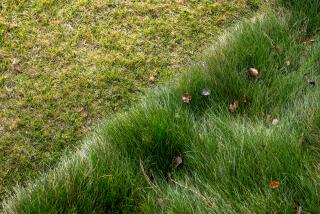Underwater Grasses on the Rise in Chesapeake Bay
- Share via
ANNAPOLIS, Md. — Underwater grasses, an important indicator of the health of the Chesapeake Bay, increased more than 7% last year.
Though grasses increased in the mid-bay, acreage declined in the upper and lower bay, the Chesapeake Bay Program reported recently.
Bay grass acreage overall increased by an estimated 4,600 acres to 68,000 acres, reversing a decline from the previous year. The acreage increased 22% in the mid-bay to 37,000 acres, while declining 2% in the upper bay to 8,800 acres and dropping 9% in the lower bay to 19,000 acres, the organization said.
The biggest increases were found in Tangier Sound, where grasses had decreased for six years. Grasses there increased 61%, from 6,600 acres in 1998 to 11,000 acres in 1991. The rebound is especially important because the sound is a large nursery for blue crabs and many species of fish, the group said.
Bay grasses are an important indicator of the health of the bay, and an important source of food and shelter for many species.
Restoring bay grasses is one of the top priorities of the Chesapeake Bay Program, which is jointly run by Maryland, Pennsylvania, Washington, the Chesapeake Bay Commission and the U.S. Environmental Protection Agency.
An updated Chesapeake Bay Agreement to be signed this summer by members of the group calls for increasing bay grasses to 114,000 acres.
“These commitments in the new agreement demonstrate the importance of underwater grasses in the bay ecosystem. It is heartening to see the recovery of the grass beds after the losses of 1998,” said Bill Matuszeski, director of the Chesapeake Bay Program.
Habitat and Erosion Protection
A century ago, as much as 600,000 acres of grasses covered the bay floor, protecting the shoreline from erosion in addition to providing habitat.
The grass beds began disappearing rapidly in the 1960s and ‘70s. Development has flushed tons of topsoil into the bay and its tributaries, burying the grasses, while nutrients from farms and sewage treatment plants have caused algae blooms that block sunlight the grasses need.
The bay lost an estimated 5,700 acres of bay grasses in 1998, the group reported last year, blaming heavy rains that washed pollutants, nutrients and silt into the bay.
Drought is believed to have raised the salinity of the bay water, hurting freshwater grasses in the upper bay and upper portions of tributaries, while helping other areas by keeping down the flow of pollutants and nutrients into the bay and helping more salt-tolerant varieties of grass.
“1999 was an extraordinary year for underwater grasses,” said Robert Orth, a professor at the Virginia Institute of Marine Science. “We observed drastic shifts in grass populations, possibly driven by higher than normal salinity levels. While the more tolerant widgeongrass and eelgrass expanded, we recorded die-back in some of the freshwater species.”
In addition to Tangier Sound, gains were reported in the Elk, Sassafras, Manoking, Big Annemesses and Honga rivers in Maryland, and in the upper and lower Potomac River. In Virginia, increases were reported in the Corrotoman River, the lower Rappahannock and in the Lynnhaven and Back Bays.
Decreases were reported in the Bohemia River, portions of the upper Chesapeake Bay, the Gunpowder River, the lower Chester River, the mouth of the Choptank River, the South River, the middle Potomac River and the mouth of the James River.
More to Read
Sign up for Essential California
The most important California stories and recommendations in your inbox every morning.
You may occasionally receive promotional content from the Los Angeles Times.









